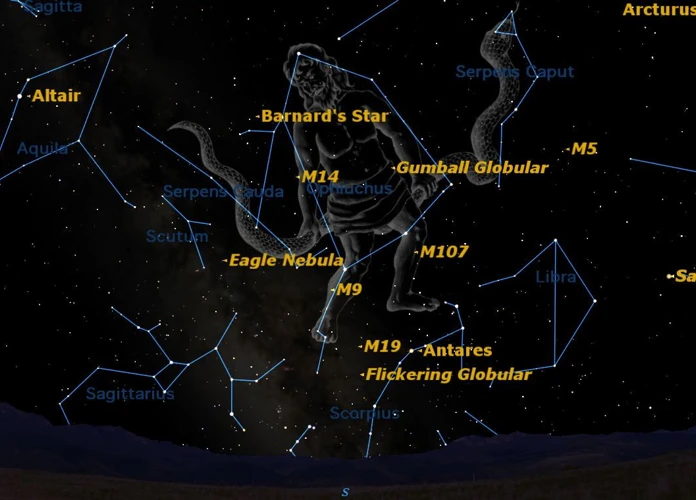In the vast expanse of the night sky, there exists a constellation that has been somewhat forgotten, overlooked by many who gaze upon the stars. This constellation, known as Ophiuchus, holds a fascinating history and mythology that is often overshadowed by the more widely recognized constellations of the zodiac. However, in recent years, there has been a resurgence of interest in this celestial figure, as people rediscover its ancient origins, its significance in astrology, and its astronomical importance. In this article, we will delve into the forgotten constellation of Ophiuchus, exploring its mythical origins, its role in Greek mythology, its place in astrology, its astronomical significance, and its resurgence in popular culture. Join us on a journey to rediscover the enigmatic Ophiuchus and uncover the secrets hidden within its celestial form.
Contents
- The Origins of Ophiuchus
- Ophiuchus in Greek Mythology
- Ophiuchus in Astrology
- Astronomical Significance of Ophiuchus
- Rediscovering Ophiuchus Today
- Conclusion
-
Frequently Asked Questions
- 1. Who discovered the Ophiuchus constellation?
- 2. Why is Ophiuchus not commonly included in the zodiac?
- 3. How is Ophiuchus represented in star maps?
- 4. What are the characteristics and traits associated with Ophiuchus in astrology?
- 5. Can Ophiuchus affect astrological charts?
- 6. Is Ophiuchus part of the zodiac shift?
- 7. How can Ophiuchus be located in the night sky?
- 8. Are there any famous myths associated with Ophiuchus?
- 9. How has Ophiuchus been portrayed in popular culture?
- 10. Is Ophiuchus recognized by all astrologers?
- References
-
Frequently Asked Questions
- 1. Who is Ophiuchus in Greek mythology?
- 2. What is the origin of the name “Ophiuchus”?
- 3. What is the significance of Ophiuchus in astrology?
- 4. How does Ophiuchus fit into the Greek mythological narrative?
- 5. Is Ophiuchus recognized in cultures other than Greek mythology?
- 6. What are some characteristics and traits associated with Ophiuchus in astrology?
- 7. How has the discovery of Ophiuchus impacted the zodiac signs?
- 8. Can Ophiuchus be observed in the night sky?
- 9. Are there any notable astronomical discoveries associated with Ophiuchus?
- 10. How does Ophiuchus make appearances in popular culture today?
- References
- Read More
The Origins of Ophiuchus
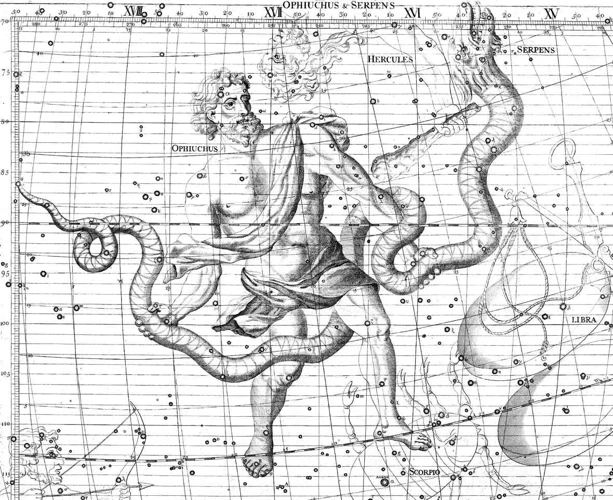
The origins of Ophiuchus can be traced back to ancient civilizations and their myths and legends. In Ancient Greek Origins, this constellation is associated with the legendary figure of Asclepius, the Greek god of medicine and healing. According to one myth, Asclepius was the son of Apollo and learned the art of healing from the centaur Chiron. His healing abilities were so extraordinary that he could even revive the dead, leading to a conflict with the gods. As a result, Zeus struck him down with a thunderbolt, but out of respect for his great contributions, he was immortalized as the constellation Ophiuchus. Other cultures also have their interpretations of Ophiuchus, such as in Egyptian mythology where it is associated with Imhotep, the god of medicine and healing. In some Native American legends, the constellation represents a great Shaman who taught his people the art of healing. These diverse interpretations highlight the universal symbolism of healing and wisdom associated with Ophiuchus, across different cultures and time periods. To learn more about the origins of Ophiuchus across various cultures, continue reading.
1.1 Ancient Greek Origins
Ancient Greek mythology provides significant insights into the origins of Ophiuchus and its association with healing and medicine. Central to these Ancient Greek Origins is the figure of Asclepius, a renowned healer and son of the Greek sun god Apollo. Asclepius was revered for his exceptional knowledge and skills in medicine, which surpassed those of any mortal physician.
According to Greek myths, Asclepius perfectly exemplified the healing powers associated with the Ophiuchus constellation. One of the most famous legends surrounding Asclepius is his encounter with a serpent. Asclepius had the ability to bring the dead back to life, and this act violated the natural order decreed by the gods. In retaliation, Zeus, the king of gods, struck Asclepius down with a thunderbolt.
The story doesn’t end there, though. Recognizing Asclepius’ immense contributions to humanity, Zeus immortalized him as the constellation Ophiuchus, depicting him holding a serpent. This representation not only symbolizes Asclepius but also highlights the link between serpents and healing. The intertwining serpents are seen as a powerful symbol of rejuvenation, regeneration, and transformation—a concept still prevalent in modern medical symbols, such as the caduceus.
These ancient Greek origins of Ophiuchus emphasize the profound connection between the constellation, healing, and the art of medicine. To delve deeper into Ophiuchus and its impact on astrology, you can explore the impact of Ophiuchus on astrological charts and how it influences our understanding of the zodiac.
1.2 Other Cultural Interpretations
In addition to its significance in Ancient Greek mythology, Ophiuchus holds various interpretations in other cultures as well. One such interpretation is found in Egyptian mythology, where Ophiuchus is associated with the god Imhotep. Imhotep, known as the god of medicine and healing, was revered for his wisdom and knowledge. The constellation Ophiuchus represents Imhotep’s divine healing abilities and serves as a symbol of hope and rejuvenation. In Native American lore, Ophiuchus takes on the role of a great Shaman. The Shaman is believed to possess extraordinary healing powers and spiritual wisdom, guiding and teaching their people the art of healing. Ophiuchus, with its position among the stars, embodies the wisdom and influence of the Shaman in Native American culture, representing the connection between the physical and spiritual realms. These cultural interpretations reveal the cross-cultural significance of Ophiuchus as a symbol of healing, wisdom, and spiritual knowledge. To discover more about how Ophiuchus is incorporated into modern astrological charts, dive into the concept of unlocking sesqui-squares in astrological charts.
Ophiuchus in Greek Mythology

In Greek mythology, Ophiuchus holds a prominent place as the constellation associated with the legendary figure of Asclepius. The mythologized story of Asclepius reveals his incredible healing abilities and his connection with serpents. According to ancient Greek tales, Asclepius was the son of the god Apollo and a mortal woman named Coronis. Raised by the wise centaur Chiron, Asclepius became a master healer, capable of curing the most incurable diseases and even bringing the dead back to life. However, his powers soon attracted the attention of the gods, who feared that mortals would become immortal through his healing arts. Asclepius’ fate was sealed when Zeus struck him down with a lightning bolt, but in honor of his contributions, he was immortalized as the constellation Ophiuchus. The association of Asclepius with serpents is significant, as it is said that he learned the secrets of healing from watching serpents bring themselves back to life by shedding their skin. This connection between Ophiuchus and serpents further amplifies the constellation’s associations with healing and wisdom. Explore more about the intriguing relationship between Ophiuchus and Greek mythology by continuing reading.
2.1 The Legend of Asclepius
| The Legend of Asclepius |
| In Greek mythology, Asclepius was a revered figure known as the god of medicine and healing. According to the legend, Asclepius was the son of Apollo, the god of healing, and a mortal woman named Coronis. Asclepius’ exceptional healing abilities were evident from birth, as he possessed a unique talent for mending wounds and curing illnesses. As he grew older, he sought to learn the art of medicine from the wise centaur Chiron. Under Chiron’s tutelage, Asclepius became a master healer, surpassing the knowledge of any mortal physician. |
| Asclepius’s healing prowess was so extraordinary that he could even revive the dead. This act alarmed the gods, specifically Hades, the ruler of the underworld, as it disrupted the natural order of life and death. In response, Zeus, the king of the gods, struck Asclepius down with a thunderbolt, fearing the consequences of mortality being conquered by humanity. However, Zeus later regretted his decision and recognized Asclepius’ immense contributions to medicine and healing. |
| To honor Asclepius, Zeus raised him to the heavens, immortalizing him as the constellation Ophiuchus. Ophiuchus is often depicted as a man holding a long serpent, representing the staff of Asclepius, which has become the symbol of medicine to this day. The symbol of a serpent coiling around a staff is known as the Rod of Asclepius, used as a symbol of healing and medicine in modern times. |
2.2 Serpent and Healing Associations
Within the realm of Greek mythology, the constellation of Ophiuchus is closely associated with serpents and healing. In fact, the symbol of Ophiuchus is depicted as a man holding a snake, which represents Asclepius and his connection to the healing arts. The serpent has long been regarded as a potent symbol of wisdom and healing in many cultures. In the case of Ophiuchus, the intertwining snake represents the staff of Asclepius, a rod with a single serpent coiled around it. This staff has become an enduring symbol of medicine and is still used today as the universal emblem for the medical profession. The association between serpents and healing in Ophiuchus mythology can be traced back to a famous myth involving the god Hermes and a pair of serpents. Legend has it that Asclepius, while still an infant, was left in the care of the wise centaur Chiron. One day, Asclepius witnessed a conflict between two serpents. In an act of compassion, he intervened and separated the serpents, placing an herb on their wounds and nursing them back to health. The serpents, in gratitude, gifted Asclepius with the knowledge of healing. Thus, the symbol of the serpent in Ophiuchus represents transformation, rebirth, and the healing journey. It serves as a reminder of the profound wisdom that can be gained through the process of healing and the sacred connection between humans and serpents in ancient mythologies.
Ophiuchus in Astrology
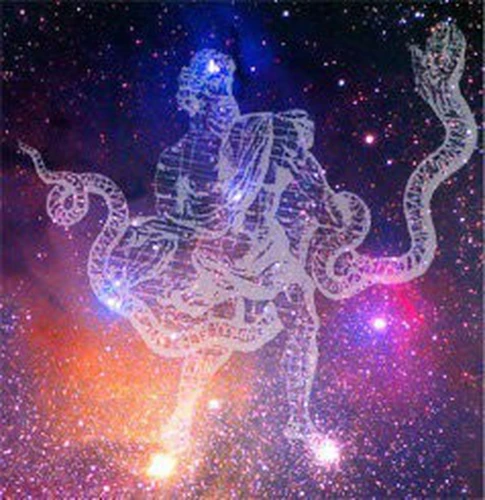
While many are familiar with the twelve zodiac signs in astrology, what often goes unnoticed is the presence of Ophiuchus. The inclusion of Ophiuchus as the thirteenth sign has sparked controversy and debate within the astrological community. The Impact of the Zodiac Shift resulting from the inclusion of Ophiuchus has led to a rearrangement of dates and the shifting of individuals’ astrological signs. Ophiuchus is believed to embody characteristics and traits that are unique and distinct from the other zodiac signs. Characteristics and Traits associated with Ophiuchus include wisdom, healing, the pursuit of knowledge, and a deep connection with spirituality. Individuals born under this sign are said to possess intuitive abilities, a strong sense of justice, and a profound desire to make a positive impact on the world. To explore the impact of the zodiac shift and delve into the characteristics and traits associated with Ophiuchus, continue reading.
3.1 The Impact of the Zodiac Shift
- Perspective Shift: The zodiac shift has had a significant impact on astrology and the way astrologers interpret and analyze birth charts. With the addition of Ophiuchus as a recognized constellation, the zodiac signs have been rearranged, resulting in a shift in the dates associated with each sign. This shift has brought about a new perspective on individuals’ astrological identities.
- Expanded Zodiac: The inclusion of Ophiuchus in the zodiac has expanded the horizons of astrological interpretations. Those born between November 30 and December 17 now fall under the sign of Ophiuchus, and this addition has introduced new traits and characteristics associated with this sign. Astrologers continue to study and analyze the impact of this addition on the overall dynamics of the zodiac.
- Personal Identity: The zodiac shift has caused individuals to reconsider their astrological identities. Many who previously identified with a specific zodiac sign now find themselves falling under the influence of Ophiuchus. This newfound identity encourages self-reflection and exploration, as individuals seek to understand the traits and qualities associated with this “new” sign and how it may shape their lives and relationships.
3.2 Characteristics and Traits
When it comes to the characteristics and traits associated with the constellation of Ophiuchus in astrology, there are a few key aspects to consider. People born under the sign of Ophiuchus are believed to possess a unique combination of traits that set them apart from others. Here are some of the characteristics commonly associated with Ophiuchus:
- Intuitive: Ophiuchus individuals are often highly intuitive and possess a strong sense of intuition, making it easier for them to understand people and situations.
- Healer: Inspired by the healing associations of the constellation, Ophiuchus natives are often drawn to fields related to healing and wellness. They have a natural inclination to help and support others.
- Wisdom: Those born under Ophiuchus are typically wise and insightful individuals. They have a thirst for knowledge and seek to constantly expand their understanding of the world.
- Charismatic: Ophiuchus individuals tend to have an innate charisma and magnetic personality. They have a natural charm that attracts others and makes them engaging companions.
- Determined: Ophiuchus natives are known for their determination and drive. Once they set their sights on a goal, they will go to great lengths to achieve it.
It is important to note that these traits are generalizations and may not apply to every individual born under Ophiuchus. Just like with other zodiac signs, each person’s unique experiences and upbringing will influence their characteristics and behavior. To learn more about the impact of Ophiuchus on astrological charts and its symbolism, you can visit our article on Ophiuchus symbol impact on astrological charts.
Astronomical Significance of Ophiuchus
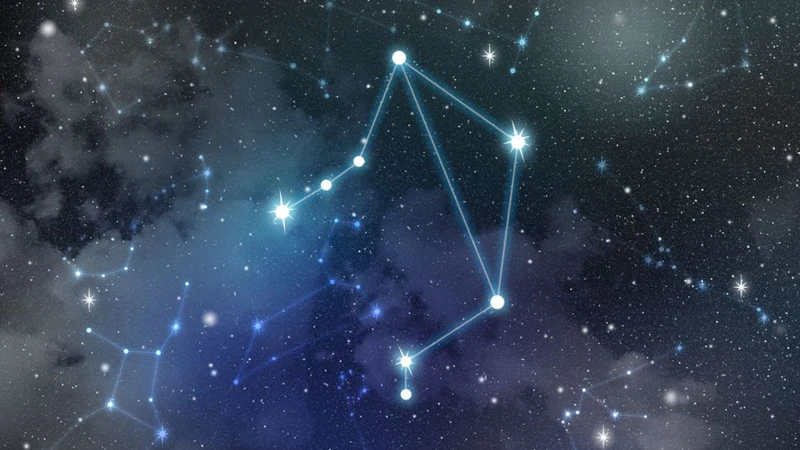
The astronomical significance of Ophiuchus lies in its position in the night sky and its proximity to other notable celestial bodies. Located between Scorpius and Sagittarius, Ophiuchus is often referred to as the “Serpent Bearer” due to its depiction in mythology. This constellation is home to several interesting objects, including Barnard’s Star, one of the closest-known stars to our solar system, and the globular cluster Messier 9, which contains hundreds of thousands of ancient stars. Ophiuchus is also in the vicinity of the galactic plane, the flat disc-like structure that contains the majority of the stars in our galaxy. This positioning makes it an exciting area for astronomers to observe and study star formation, galactic dynamics, and various other astronomical phenomena. As we continue to explore and make new discoveries, the astronomical significance of Ophiuchus in unraveling the mysteries of the universe becomes more apparent.
4.1 Ophiuchus in the Night Sky
In the vast expanse of the night sky, Ophiuchus is a celestial marvel that captivates stargazers with its prominent presence. When looking up at the heavens, one can locate Ophiuchus between the constellations of Sagittarius and Scorpius. Its name, in fact, originates from the Greek word meaning “serpent-bearer,” as the constellation is often depicted as a figure holding a serpent. Ophiuchus is a large constellation that sprawls across 948 square degrees of the celestial sphere, making it the 11th largest constellation in terms of size. However, its visibility may vary depending on the observer’s location and the time of year. In the Northern Hemisphere, Ophiuchus can typically be spotted during the summer months, while in the Southern Hemisphere, it is more visible during winter. It is best seen in clear, dark skies away from city lights, allowing its stars to shine brightly. In total, there are 83 stars within the constellation that make up its distinctive shape, with Rasalhague being the brightest of them. To better visualize Ophiuchus in the night sky, stargazers can use star charts or smartphone apps specifically designed for astronomy enthusiasts. Once you acquaint yourself with the location and appearance of Ophiuchus, you can appreciate its cosmic beauty the next time you gaze up into the mesmerizing night sky.
4.2 Exploration and Discoveries
Exploration and discoveries related to Ophiuchus have greatly contributed to our understanding of the universe and the celestial bodies that inhabit it. Scientists and astronomers have conducted numerous studies and observations to unravel the mysteries of this forgotten constellation. One significant discovery pertaining to Ophiuchus is the existence of star-forming regions within its boundaries. These regions, known as dark nebulas, are dense clouds of interstellar dust and gas. They serve as stellar nurseries, giving birth to new stars through the process of gravitational collapse. The study of these star-forming regions within Ophiuchus has provided valuable insights into the formation and evolution of stars. Exploration of Ophiuchus has also shed light on the presence of exoplanets, planets that exist beyond our solar system. Astronomers have identified exoplanets in binary star systems within the constellation, where two stars orbit each other. These exoplanets have diverse characteristics and offer intriguing possibilities for further exploration of extraterrestrial life. Advancements in technology, such as powerful telescopes and space missions, have enabled scientists to delve deeper into the mysteries of Ophiuchus. They continue to probe this constellation, uncovering fascinating discoveries and pushing the boundaries of our understanding of the universe.
Rediscovering Ophiuchus Today
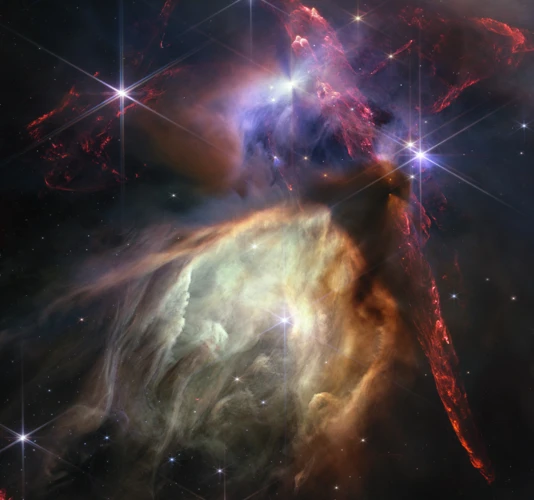
The forgotten constellation of Ophiuchus is experiencing a resurgence of interest and rediscovery in popular culture today. In movies, books, and artwork, Ophiuchus has captured the imagination of many, giving rise to its revival in modern depictions of the zodiac and astrology. Through various mediums and platforms, Ophiuchus has become a symbol of mystery, wisdom, and hidden potential. In the realm of astrology, there has been an ongoing debate about the inclusion of Ophiuchus as the thirteenth sign of the zodiac. Some astrologers argue that this addition would better align with the actual positions of the constellations. While this remains a topic of discussion, the notion of Ophiuchus as an astrological sign has intrigued many, leading to a deeper exploration of its characteristics and influence. Discover more about the fascinating connections between Ophiuchus and modern astrology in the following sections.
5.1 Popular Culture References
In recent years, Ophiuchus has experienced a resurgence in popular culture, making appearances in various forms of entertainment. Movies, television shows, and books have incorporated references to this forgotten constellation, introducing it to new audiences around the world. One notable example is the Marvel Cinematic Universe, where the character Doctor Strange, portrayed by Benedict Cumberbatch, wears a pendant in the shape of the Ophiuchus symbol. This subtle nod to the constellation highlights its association with healing and wisdom, reflecting the character’s role as a powerful sorcerer. Additionally, Ophiuchus has made appearances in video games, such as the popular RPG series Final Fantasy, where it is often depicted as a guardian or a source of mystical power. These popular culture references not only bring awareness to Ophiuchus but also contribute to its growing mythology and influence in modern storytelling. Whether through subtle symbols or direct portrayals, Ophiuchus continues to captivate and inspire audiences in the realm of popular culture.
5.2 Ophiuchus and Modern Astrology
When it comes to modern astrology, Ophiuchus has sparked both interest and controversy. Traditionally, Western astrology has been based on a twelve-sign division of the zodiac, with each sign representing specific personality traits and characteristics. However, with the inclusion of Ophiuchus as the thirteenth sign, there has been a shift in the astrological landscape.
Ophiuchus is believed to be a sign that falls between Scorpio and Sagittarius, with its dates ranging from November 29 to December 17. Those born under the sign of Ophiuchus are said to possess qualities of healing, wisdom, transformation, and spiritual growth. Their intuitive nature and ability to adapt make them natural healers and teachers.
Despite the growing interest, Ophiuchus is not widely recognized or included in mainstream astrology. This is mainly due to the centuries-old tradition and the established system of twelve zodiac signs. Skeptics argue that the inclusion of Ophiuchus would disrupt the already established astrological interpretations and predictions.
However, proponents of Ophiuchus believe that its inclusion adds depth and nuance to astrological readings. They argue that individuals born under Ophiuchus possess unique characteristics that are not encompassed by the traditional signs. The resurgence of interest in Ophiuchus has led to discussions and debates among astrologers about whether or not to incorporate it into mainstream astrology.
While Ophiuchus may not yet be widely recognized in modern astrology, its presence and significance continue to captivate the curious minds and challenge the traditional boundaries of astrological understanding.
For more information on how Ophiuchus impacts astrological charts and interpretations, check out our article on the impact of Ophiuchus on astrological charts.
Conclusion

In Conclusion, Ophiuchus, the forgotten constellation, has been brought back into the spotlight. Through the exploration of its origins, mythology, astrology, and astronomical significance, we have rediscovered the rich history and symbolism embedded within this celestial figure. Ophiuchus, often overshadowed by the more well-known constellations of the zodiac, holds its own unique story and significance. Its roots can be traced back to ancient Greek mythology, where it represents the legendary healer, Asclepius. Across different cultures, Ophiuchus symbolizes healing, wisdom, and spiritual enlightenment. In astrology, the rediscovery of Ophiuchus and its inclusion as a 13th zodiac sign has sparked debate and interest among astrologers and enthusiasts. Astronomically, Ophiuchus offers a captivating sight in the night sky, with its distinctive shape and neighboring constellations. As we delve deeper into the mysteries of the universe, the significance of Ophiuchus continues to be unveiled. From popular culture references to modern astrology, Ophiuchus has captured the imagination of many, further cementing its place in the celestial realm. In conclusion, the rediscovery of Ophiuchus serves as a reminder that there is still much to learn and explore in the vast expanse of our cosmos.
Frequently Asked Questions

1. Who discovered the Ophiuchus constellation?
The Ophiuchus constellation has been known since ancient times, and its discovery cannot be attributed to a single individual. It has been observed and recognized by many cultures throughout history.
2. Why is Ophiuchus not commonly included in the zodiac?
Ophiuchus is not commonly included in the zodiac because the zodiac consists of twelve equal divisions, each corresponding to a specific period of the year. Incorporating Ophiuchus would require altering the current zodiac system.
3. How is Ophiuchus represented in star maps?
Ophiuchus is typically represented as a figure holding a snake or serpent. The constellation is often depicted as a man clasping a large snake, symbolizing the mythical association with healing and medicine.
4. What are the characteristics and traits associated with Ophiuchus in astrology?
In astrology, Ophiuchus is believed to have traits such as being intuitive, passionate, and having a strong connection to the spiritual realm. Those born under Ophiuchus may possess healing abilities and a deep understanding of the mysteries of life.
5. Can Ophiuchus affect astrological charts?
Yes, the inclusion of Ophiuchus in astrological charts can have an impact. It adds an additional astrological sign and can potentially alter the placements and interpretations of other celestial bodies in the chart.
6. Is Ophiuchus part of the zodiac shift?
Yes, the concept of the “zodiac shift” refers to the idea that the Earth’s axial precession has caused a shift in the position of the constellations. Ophiuchus is one of the constellations that may be affected by this shift.
7. How can Ophiuchus be located in the night sky?
To locate Ophiuchus in the night sky, look for its brightest star, Rasalhague, which marks the head of the serpent. Ophiuchus is situated between the constellations of Scorpius and Sagittarius.
8. Are there any famous myths associated with Ophiuchus?
One of the most famous myths associated with Ophiuchus is the legend of Asclepius in Greek mythology. Asclepius was a skilled healer who was eventually transformed into the constellation by the gods.
9. How has Ophiuchus been portrayed in popular culture?
Ophiuchus has made appearances in various forms of popular culture, including books, movies, and video games. Its representation often emphasizes the mystical and healing aspects associated with the constellation.
10. Is Ophiuchus recognized by all astrologers?
Ophiuchus is not universally recognized by all astrologers. While some astrologers choose to incorporate it into their practice, others adhere strictly to the traditional twelve zodiac signs.
References
Frequently Asked Questions

1. Who is Ophiuchus in Greek mythology?
Ophiuchus, also known as Serpentarius, is a figure from Greek mythology. He is often depicted as a man holding a snake or a serpent.
2. What is the origin of the name “Ophiuchus”?
The name “Ophiuchus” comes from the Greek words “ophis,” meaning snake, and “ouchos,” meaning holding. Together, they represent the constellation’s association with the serpent bearer.
3. What is the significance of Ophiuchus in astrology?
Ophiuchus is not traditionally considered as one of the twelve zodiac signs. However, its presence in the night sky has led to debates and discussions about its astrological significance.
4. How does Ophiuchus fit into the Greek mythological narrative?
In Greek mythology, Ophiuchus is often associated with the figure of Asclepius, the god of healing. He is believed to have possessed great knowledge of medicine and was later honored as a constellation.
5. Is Ophiuchus recognized in cultures other than Greek mythology?
Yes, Ophiuchus has been mentioned in various cultural narratives. In Egyptian mythology, he is associated with Imhotep, a renowned physician and architect. In Babylonian astronomy, he is known as “MUL.APIN,” the snake god.
6. What are some characteristics and traits associated with Ophiuchus in astrology?
According to some astrologers, people born under the Ophiuchus sign are believed to possess traits such as wisdom, healing abilities, intuition, and a desire for knowledge. They may also exhibit strong leadership qualities.
7. How has the discovery of Ophiuchus impacted the zodiac signs?
The discovery of Ophiuchus has sparked discussions about whether the zodiac should include thirteen signs instead of twelve. However, the traditional zodiac system remains widely accepted and practiced.
8. Can Ophiuchus be observed in the night sky?
Yes, Ophiuchus is visible in the night sky, particularly during certain times of the year. It is located between the constellations of Scorpius and Sagittarius.
9. Are there any notable astronomical discoveries associated with Ophiuchus?
Scientists have made significant discoveries within the boundaries of Ophiuchus, including the identification of various star clusters, nebulae, and exoplanets. Ongoing research continues to shed light on this intriguing constellation.
10. How does Ophiuchus make appearances in popular culture today?
Ophiuchus has made appearances in modern literature, films, and artwork. It often represents themes of healing, wisdom, and the mysterious nature of the universe.
References
- Ophiuchus – Interactive Stars Daily Horoscopes
- What is Ophiuchus? – Quora
- Ophiuchus, 13th constellation of Zodiac | Tonight – EarthSky

